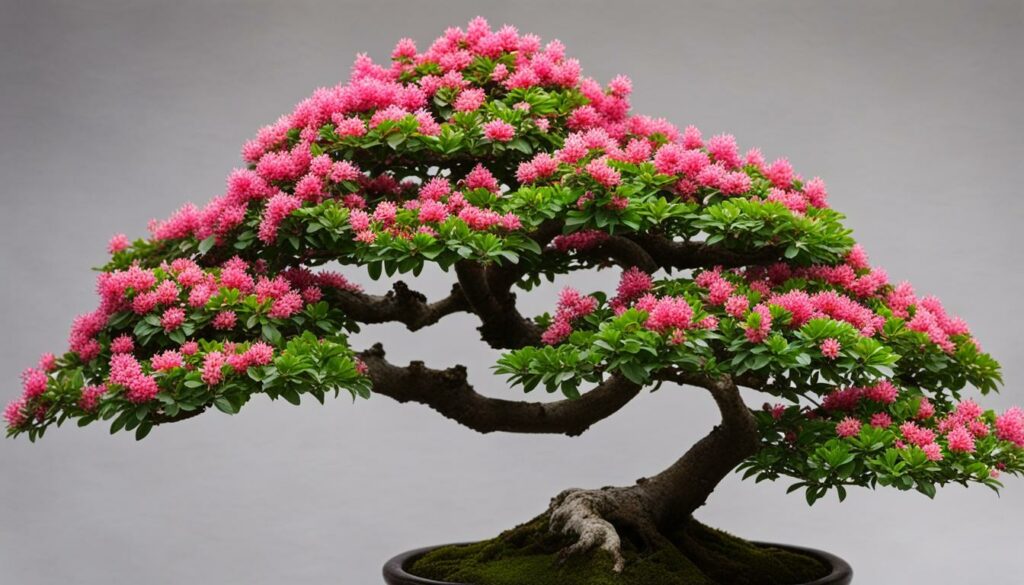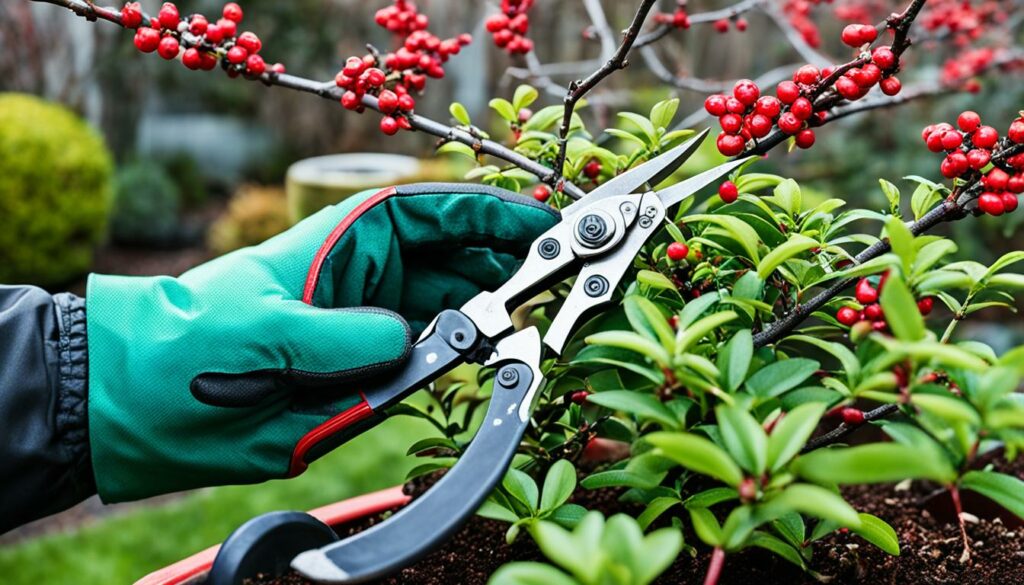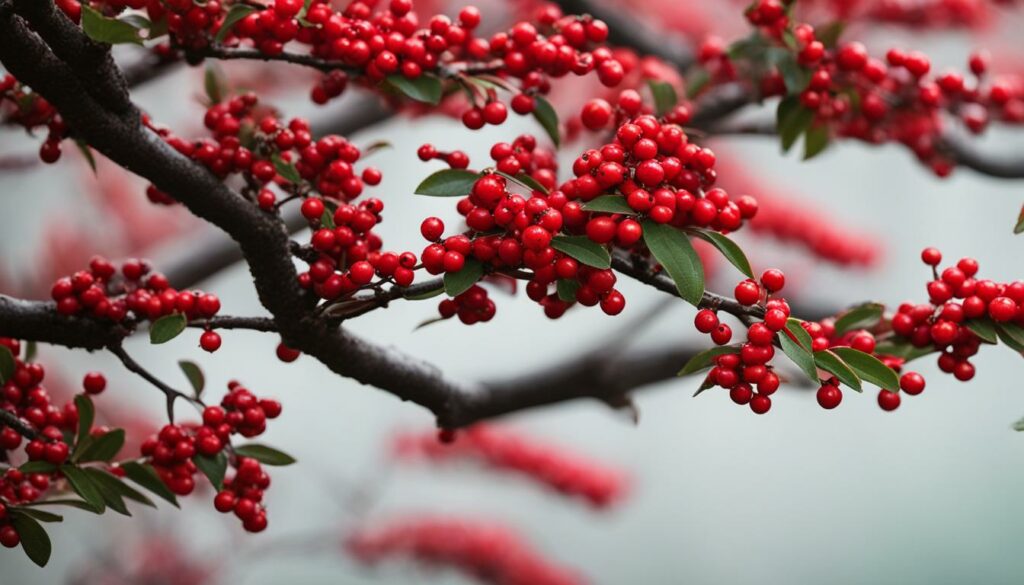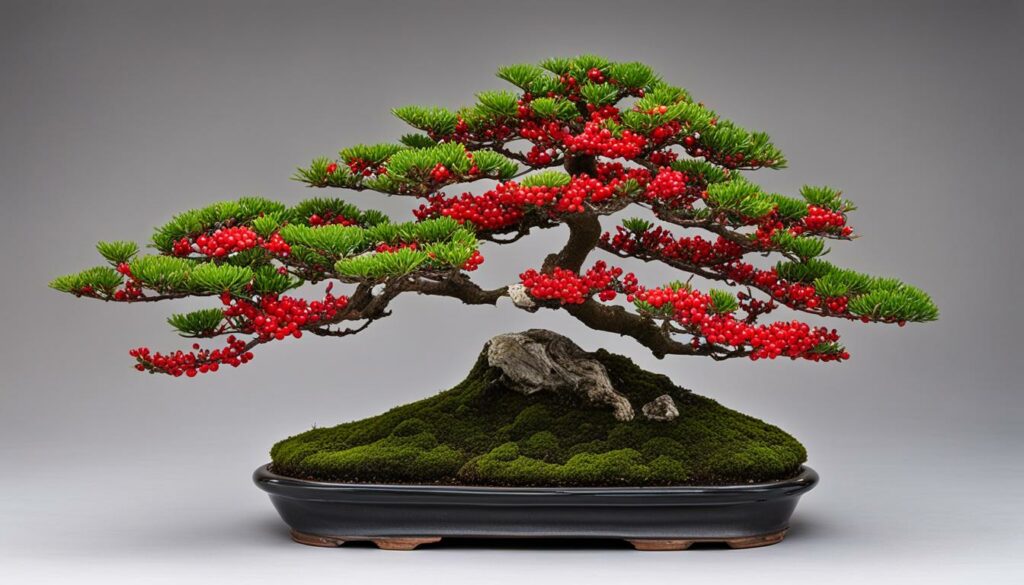If you’re looking for a stunning and unique addition to your indoor garden, look no further than the Japanese Winterberry bonsai. Also known as Ilex verticillata, this deciduous bonsai is a true beauty, with elegant branch structure and vibrant red berries that last throughout the winter.
Not only is the Japanese Winterberry bonsai visually appealing, but it is also relatively easy to care for with the right techniques. By following the care tips and shaping techniques we’ll cover in this article, you can keep your Japanese Winterberry bonsai healthy and thriving for years to come.
Key Takeaways:
- The Japanese Winterberry bonsai is a visually stunning addition to any indoor garden
- With the right care tips and techniques, the Japanese Winterberry bonsai is relatively easy to care for
- Shaping and styling techniques can help you create your desired aesthetic for your Japanese Winterberry bonsai
- The Japanese Winterberry bonsai is also known as Ilex verticillata and is a deciduous bonsai species
- Japanese Winterberry bonsai offer unique possibilities for shaping and styling
Introduction to Japanese Winterberry Bonsai
Welcome to the fascinating world of Japanese Winterberry bonsai, one of the most beautiful Bonsai Tree Species. This bonsai is known by the scientific name Ilex verticillata and native to North America. Japanese Winterberry bonsai is a deciduous bonsai with an elegant branch structure that sets it apart from other bonsai species. What’s more, it boasts vibrant red berries that add a dash of color and romance to your indoor garden.
This Bonsai Tree Species also boasts a unique feature that other bonsai cannot match – its leaves change color depending on the seasons. During spring, the leaves start to bud with a fresh green color that brightens up your indoor garden. As summer comes, the leaves turn into a rich green shade, perfect for creating a natural ambiance. But as winter approaches, the leaves turn to a warm burgundy color, hence the name “Winterberry.”
The Japanese Winterberry bonsai is truly a sight to behold and a favorite among Bonsai enthusiasts due to its fascinating features. In the next sections, we’ll dive deeper into the care tips, techniques for shaping and styling as well as other interesting facts about this incredible bonsai species.

Care Tips for Japanese Winterberry Bonsai
To keep your Japanese Winterberry bonsai healthy and thriving, here are some essential care tips you need to follow:
1. Watering
Watering is crucial for the growth and health of your Japanese Winterberry bonsai. You need to make sure that the soil is wet but not waterlogged. Water your bonsai when the soil starts to feel slightly dry to the touch. The frequency of watering depends on the temperature and humidity of your environment.
2. Pruning
Pruning is necessary to maintain the shape and size of your bonsai. You need to remove dead or diseased branches and shape the bonsai as it grows. The best time to prune your Japanese Winterberry bonsai is during its dormant season, which is in late winter or early spring.
3. Temperature
Your Japanese Winterberry bonsai prefers cool temperatures between 40°F to 60°F (4.4°C to 15.6°C) in the winter months. During the summer, it can tolerate warmer temperatures, but keep it out of direct sunlight to avoid dehydration.
4. Light
Your Japanese Winterberry bonsai needs bright and indirect light to thrive. Place your bonsai near a window that receives plenty of natural light. If you live in a location with low light levels, you can use artificial lighting to supplement your bonsai’s light requirements.

Tip: To ensure the health and vitality of your Japanese Winterberry bonsai, avoid exposing it to sudden changes in temperature or humidity.
Techniques for Shaping Japanese Winterberry Bonsai
Shaping a bonsai is an art form that requires creative expression and skillful technique. Japanese Winterberry bonsai, or Ilex verticillata, provides unique possibilities for shaping and styling to create the desired aesthetic. Whether you’re seeking traditional forms or more intricate designs, the Japanese Winterberry bonsai can offer a beautiful and captivating addition to your indoor garden.
Here are some popular shaping techniques you can use to guide the growth of your Japanese Winterberry bonsai:
- Wiring: This technique involves using wire to manipulate the shape and direction of the bonsai’s branches and trunk. It’s important to carefully wrap the wire around the branches to avoid damaging them and to periodically check the wiring to ensure it’s not too tight or cutting into the bark.
- Pruning and Pinching: Regular pruning and pinching of new growth are essential techniques for maintaining the shape of your Japanese Winterberry bonsai. This involves cutting away unwanted leaves and branches to encourage new growth in the desired direction.
- Bud Selection: By selectively removing buds, you can control the direction of growth on your bonsai and encourage the development of a specific form or shape.
- Jin and Shari: Jin and Shari are techniques used to create a deadwood effect on the branches and trunk of your Japanese Winterberry bonsai. Jin involves removing the bark from a branch to create an aged, weathered look, while Shari involves stripping the bark from the trunk to expose the wood beneath. These techniques can add a unique and striking character to your bonsai.
By exploring these shaping techniques, you can develop your skills and create a beautiful Japanese Winterberry bonsai that reflects your personal style and vision.

Conclusion
You have now discovered the captivating beauty of the Japanese Winterberry bonsai, a remarkable Bonsai Tree Species. With its elegant charm, vibrant red berries, and unique shaping possibilities, it is a desirable choice for any indoor garden. Remember to follow the provided care tips and techniques to ensure the health and vitality of your Ilex verticillata, a deciduous bonsai that will continue to fascinate you for years to come.
FAQ
What is the Japanese Winterberry bonsai?
The Japanese Winterberry bonsai, also known as Ilex verticillata, is a deciduous bonsai species that is known for its elegant branch structure and vibrant red berries during the winter season.
How do I care for my Japanese Winterberry bonsai?
To care for your Japanese Winterberry bonsai, it is important to provide it with the right amount of water, keeping the soil evenly moist but not soggy. Additionally, this deciduous bonsai prefers a bright location with indirect sunlight and a cool temperature range of 40-50°F (4-10°C) during the winter dormancy period.
Can I shape my Japanese Winterberry bonsai?
Yes, shaping and styling your Japanese Winterberry bonsai is part of the art form. There are various techniques you can use to shape and create the desired aesthetic, such as wiring, pruning, and selective trimming. However, it is important to research and seek guidance to ensure you do not harm the bonsai in the process.
How often does the Japanese Winterberry bonsai produce red berries?
The Japanese Winterberry bonsai produces vibrant red berries during the winter months when it is in its dormant phase. The berries are an attractive feature of this bonsai species and can add a pop of color to your indoor garden during the colder months.
Can I keep my Japanese Winterberry bonsai outdoors?
Yes, you can keep your Japanese Winterberry bonsai outdoors during the warm months, but it should be protected from extreme temperatures and excessive sunlight. It is important to gradually acclimate your bonsai to outdoor conditions and provide it with the necessary care and protection to ensure its health and survival.


